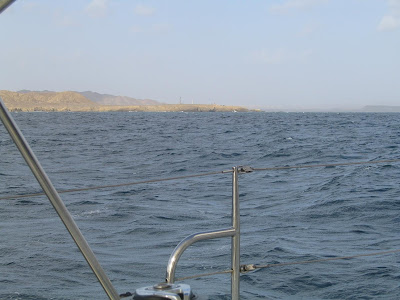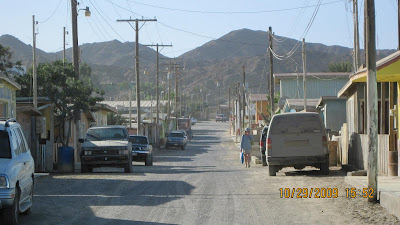Fortunately, the forward tank macerator is "easily accessible". All things on a boat are relative, so this is what easy accessibility looks like when two crew members attack a balky pump. They have already removed a drawer unit to get to this point.
 The most vulnerable part of a pump is its impeller, so that is the first thing to check. Removing the pump for inspection should have been a 4-step 15 minute job.
The most vulnerable part of a pump is its impeller, so that is the first thing to check. Removing the pump for inspection should have been a 4-step 15 minute job.- Remove the outlet hose
- Remove the 4 pump mounting screws
- Unscrew the pump from the inlet Tee
- Take the pump apart and inspect the impeller.
- Remove the outlet hose
- Remove the 4 pump mounting screws
- Cut the two power supply wires
- Remove the inlet hoses from the Tee
- Take the assembly outside and unscrew the pump from the inlet Tee
- Take the pump apart and inspect the impeller.
However, we found that we could still not remove the pump from the Tee. I decided to replace the pump and Tee. I walked many miles back and forth between the four marine stores in Cabo. I finally found a Jabsco pump, a brass Tee, and two brass IPT to barb adapters. While looking at a plumbing supply store, two Mexican plumbers offered to help me remove the Tee. Needless to say the pump remained welded not even giving up to the blandishments of a pipe wrench and a piece of pump through the Tee.
 Imagine the chuckle we got when we read the directions for assembling the new pump to the new Tee. The instructions say to use Teflon thread tape and hand tighten only. I have asked Catalina to send me a picture of the hands that do the tightening at the Florida plant because I feel our governor of California is moonlighting. I also asked for the brand of Teflon tape since it is more tenacious than any brand that I have ever worked with. Here is the final assembly $400 later.
Imagine the chuckle we got when we read the directions for assembling the new pump to the new Tee. The instructions say to use Teflon thread tape and hand tighten only. I have asked Catalina to send me a picture of the hands that do the tightening at the Florida plant because I feel our governor of California is moonlighting. I also asked for the brand of Teflon tape since it is more tenacious than any brand that I have ever worked with. Here is the final assembly $400 later. I must confess that since this episode I have learned that the pump can in fact be disassembled without removing the Tee. You do have to be able to reach the screw heads that face the Tee. As you can see the pump's impeller does have a broken leg. It looks as if the replacement impeller that I bought for the Jabsco replacement pump will fit this ShurFlo pump. That is good news if I ever have trouble with the other aft tank macerator pump.
I must confess that since this episode I have learned that the pump can in fact be disassembled without removing the Tee. You do have to be able to reach the screw heads that face the Tee. As you can see the pump's impeller does have a broken leg. It looks as if the replacement impeller that I bought for the Jabsco replacement pump will fit this ShurFlo pump. That is good news if I ever have trouble with the other aft tank macerator pump. Well, speak of the devil. On the trip to La Cruz we saw that the aft macerator pump was not working. It showed the same symptoms as the earlier failure. But now I know the not so simple seven step process right? Not do fast. The aft pump is not easily accessible even by boat standards. Given the tight space and the obstructing wiring I do not see how I can remove the entire assemble. I have asked Catalina for any advice they might have on how to loosen the pump from the Tee. Several emails and phone inquiries have not yielded any useful advise other than try using anti-bond on the threads.
Well, speak of the devil. On the trip to La Cruz we saw that the aft macerator pump was not working. It showed the same symptoms as the earlier failure. But now I know the not so simple seven step process right? Not do fast. The aft pump is not easily accessible even by boat standards. Given the tight space and the obstructing wiring I do not see how I can remove the entire assemble. I have asked Catalina for any advice they might have on how to loosen the pump from the Tee. Several emails and phone inquiries have not yielded any useful advise other than try using anti-bond on the threads. I am aware that running an impellor pump dry can wear the impellor. It is hard to tell sometimes if the pump is in fact pumping given the ambient noise if the engine is running. Perhaps my problems are caused by operator error. I am taking the advice that Jerry Douglas gave at this year's rendevous--put a piece of clear hose in the discharge line so you can monitor the pumping (or not pumping) visually as well as aditorily.
I am aware that running an impellor pump dry can wear the impellor. It is hard to tell sometimes if the pump is in fact pumping given the ambient noise if the engine is running. Perhaps my problems are caused by operator error. I am taking the advice that Jerry Douglas gave at this year's rendevous--put a piece of clear hose in the discharge line so you can monitor the pumping (or not pumping) visually as well as aditorily.On one of my first days having breakfast at Anna Banana's I was introduced to a local person who was recommended for general boat work. His name is Butch and I looked him up to repair my macerator pump. He concurred that the sealant looked like 3M 5200 to him and that it would be ill advised for anyone to use this product for this purpose. He agreed to replace the impeller in the pump and to replace the original opaque hose with a clear one. This took him two hours and he charged me $90--a bargain!







 Once around the arches, we see
Once around the arches, we see 




















 Once we finished the race course we restarted the engine and rounded the point at Turtle Bay.
Once we finished the race course we restarted the engine and rounded the point at Turtle Bay.












